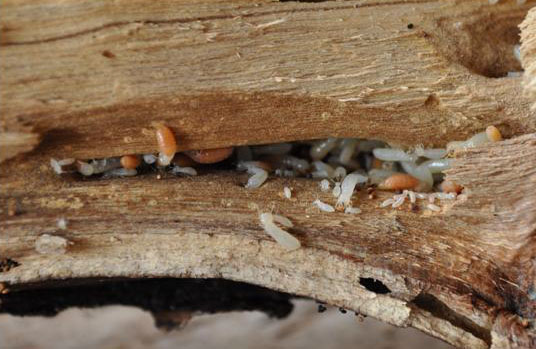The genetic basis of eusociality in termites described
The genetic basis of eusociality in termites described
 One phenomenon that fascinated Charles Darwin and many other researchers since is the emergence of huge, complex societies. Even more exciting is that the societies of termites and ants evolved independently from each other. Although unrelated, termites and ants are very similar: they both have a so-called eusocial way of living. This includes distinctive features such as the creation of reproductive castes (queens and workers) or a complex system of division of workers and soldiers. However, termites and ants are not closely related. While termites first emerged around 150 million years from within the cockroaches, ants and other eusocial Hymenoptera (e.g. bees and wasps) appeared 50 million years later on a very distant branch of the insect family tree.
One phenomenon that fascinated Charles Darwin and many other researchers since is the emergence of huge, complex societies. Even more exciting is that the societies of termites and ants evolved independently from each other. Although unrelated, termites and ants are very similar: they both have a so-called eusocial way of living. This includes distinctive features such as the creation of reproductive castes (queens and workers) or a complex system of division of workers and soldiers. However, termites and ants are not closely related. While termites first emerged around 150 million years from within the cockroaches, ants and other eusocial Hymenoptera (e.g. bees and wasps) appeared 50 million years later on a very distant branch of the insect family tree.
An international team of researchers, three of which are Xavier Bellés, M. Dolors Piulachs and Guillem Ylla, researchers at IBE, have sequenced for the first time the genome of a cockroach, the Blattella germanica, and that of the dry wood termite, the Cryptotermes secundus. By doing this, and with the aim of finding the keys to the evolution towards eusociality, the molecular basis of one group has been compared to the molecular basis of the other group. The research has been published in Nature Ecology and Evolution.
Different origins, same evolution
The genomes, the genetic activity and the complete set of proteins (proteome) of three termite species were compared to those of the cockroach. Also, the scientists compared the results with corresponding data from 15 other insect species, including several ant species. With the help of specialised algorithms they reconstructed the genetic configuration of the ancestors of today’s termites. In this way they were able to retrace the appearance of random mutations that enabled the evolution of eusociality.
The research has revealed that in termites a related but clearly distinct family of chemoreceptors to the ants and bees had been specialised for the recognition of pheromones. “Communication is essential for all biological interactions, especially for social organisms. Whereas humans mainly communicate by speech, insects mainly use chemicals”, Xavier Bellés states. Chemical communication via pheromones enables members of insect societies to, for example, recognise nest mates and differentiate between castes. This form of communication is vital for the colony life of these animals. These results are surprisingly similar to findings from previous studies on the evolution of eusociality in bees and ants.
Further analyses show that in termites a related but clearly distinct family of chemoreceptors to the ants ans bees had been specialised for the recognition of pheromones. “This is, therefore, a classic case of convergent evolution: both groups evolved similar molecular mechanisms for a eusocial lifestyle under similar selection pressures”, says genomic expert Mark Harrison, first author of the study. To Bellés, this suggests “there were not many solutions available to invent, from the evolution perspective, a eusocial organisation within the group of insects”. The scientists found evidence for further convergences, including genes that play a role in the synthesis of hydrocarbons in the cuticle, the hard shell of insects. These cuticular hydrocarbons play an important role in communication as they contribute to a distinctive blend of aromas that have been linked to colony, caste and reproductive status.
One of the most relevant results of the study is the discovery of one of the most important causes of the genomic changes that supported these molecular adaptations to be so-called transposons. These are DNA regions that possess the ability to duplicate and change position within a genome. “We were able to deduce that, long before the evolution of termites, one particular class of transposons led to the expansion of gene families involved in communication”, states Evelien Jongepier, researcher at the University of Münster. These protein expansions have led to the cockroach possessing possibly the largest so far recorded insect proteome, creating a high adaptation potential. These large protein families have then adapted towards a more sophisticated communication system, thus enabling the evolution of eusociality.
REFERENCE ARTICLE: Harrison M. C., Jongepier E., Robertson H. M. et al. (2018): Hemimetabolous genomes reveal molecular basis of termite eusociality; Nature Ecology and Evolution, doi:10.1038/s41559-017-0459-1
Photo: Cryptotermes secundus (by Judith Korb)
